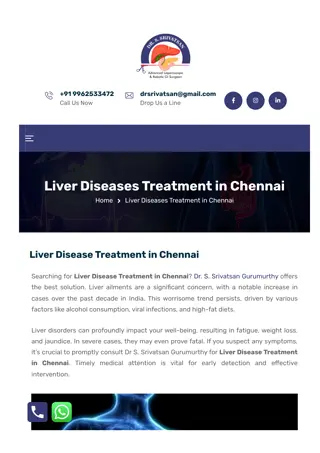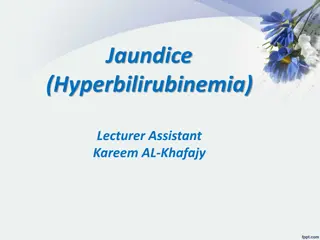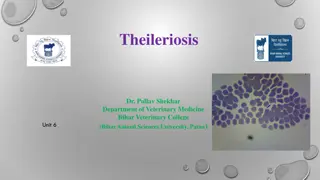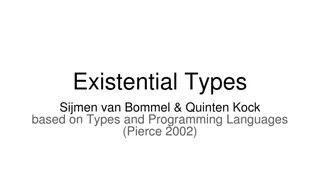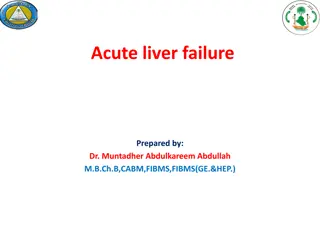Understanding Liver Function Tests in Cholestatic Injury
Cholestatic liver disease affects Alkaline Phosphatase (ALP) and bilirubin levels, indicating bile duct damage. GGT and 5'-Nucleotidase help differentiate hepatobiliary vs. bone origin of ALP elevation. ALP is produced by bile duct epithelium and can be normal in acute biliary obstruction. GGT and N
1 views • 33 slides
Understanding Paroxysmal Nocturnal Hemoglobinuria (PNH)
Paroxysmal Nocturnal Hemoglobinuria (PNH) is a rare blood disorder characterized by the destruction of red blood cells in the bloodstream, leading to anemia, hemoglobinuria, jaundice, and other symptoms. It is often challenging to diagnose due to its rarity. PNH can be a thrombophilic state, causing
0 views • 20 slides
NEONATAL JAUNDICE
Neonatal jaundice, a common condition in newborns, results from elevated bilirubin levels. While often benign, high levels can lead to complications like kernicterus. Recognizing risk factors, limitations of clinical assessment, and appropriate evaluation and treatment are crucial in managing neonat
1 views • 48 slides
Liver Diseases Treatment in Chennai - Dr S. Srivatsan Gurumurthy
Liver disorders can profoundly impact your well-being, resulting in fatigue, weight loss, and jaundice. In severe cases, they may even prove fatal. If you suspect any symptoms, it\u2019s crucial to promptly consult Dr S. Srivatsan Gurumurthy for Liver Disease Treatment in Chennai. Timely medical att
1 views • 6 slides
Understanding Blood Groups and Their Significance
Human blood types are determined by specific antigens and antibodies present on red blood cells, influencing crucial aspects like blood transfusions and familial relationships in forensic medicine. The ABO system, with its four main blood types (A, B, AB, O), plays a vital role in categorizing blood
7 views • 14 slides
Understanding Cholestasis: Etiology, Clinical Manifestations, and Complications
Cholestasis is characterized by reduced bile flow and elevated direct bilirubin. It is critical to differentiate it from neonatal jaundice. In conditions like biliary atresia and 1-antitrypsin deficiency, early diagnosis and intervention are crucial to prevent liver failure. Clinical manifestations
5 views • 14 slides
Understanding Bilirubin Metabolism and Different Types of Jaundice
Explore the detailed information about bilirubin metabolism and various types of jaundice, including their clinical presentations, etiologies, and management strategies. Learn to differentiate between different types of jaundice based on case scenarios and understand the functional anatomy and physi
1 views • 33 slides
Understanding Thyroid Disorders in Children - Clinical Case Study
This clinical case study focuses on a pediatric patient presenting with abdominal enlargement and a history of delayed development. Key aspects covered include birth and maternal history, immediate postnatal course, developmental milestones, and past medical history. The diagnosis process involves c
0 views • 56 slides
Understanding Hyperbilirubinemia in Infants - A Comprehensive Overview
This educational content delves into hyperbilirubinemia, focusing on its definition, causes, metabolic processes, associated complications, and treatment options like phototherapy and exchange blood transfusion. Key topics covered include physiologic jaundice, the seriousness of unconjugated bilirub
0 views • 16 slides
Understanding Bilirubin: Estimation, Implications, and Causes of Jaundice
Bilirubin, a yellow compound in the catabolic pathway, plays a crucial role in health. Estimating serum bilirubin levels is key in diagnosing conditions like jaundice. Elevated levels, above 2 mg/dl, can indicate disease. Jaundice, characterized by skin and eye discoloration, has pre-hepatic, hepati
0 views • 16 slides
Understanding Instruction Set Architecture and Data Types in Computer Systems
In computer architecture, the Instruction Set Architecture (ISA) level is crucial in defining how a processor executes instructions. This includes the formal defining documents, memory models, registers, and various data types that can be supported. The ISA level specifies the capabilities of a proc
2 views • 13 slides
Understanding Bovine Theileriosis: Causes, Symptoms, and Prevention
Bovine theileriosis is a tick-borne haemoprotozoan disease that causes significant economic losses in livestock due to high mortality rates, weight loss, abortion, and reduced milk yield. The disease is characterized by fever, anemia, and respiratory and digestive disorders. It is caused by parasite
1 views • 11 slides
Understanding Hotel Classification and Types
Hotel classification and types cover various aspects such as facilities, services, amenities, guest types, and factors influencing hotel classification. From resort hotels to airport hotels and city center accommodations, each hotel type serves different purposes and caters to diverse guest preferen
0 views • 44 slides
Comprehensive Guide to Wound Care: Types, Dressings, and Practices
Understanding wound care is crucial for proper healing. This guide covers types of wounds, purposes of wound dressing, different dressing types, and helpful practice guidelines. Learn about intentional and unintentional wounds, dressing purposes like protection and absorption, and types of dressings
1 views • 10 slides
Understanding Choledocholithiasis: Causes, Symptoms, and Diagnosis
Choledocholithiasis, the presence of stones in the common bile duct, is a common condition found in a percentage of patients with gallstones. The stones can be primary or secondary, causing a range of clinical manifestations from silent obstruction to cholangitis or gallstone pancreatitis. Diagnosis
0 views • 40 slides
Anemia in Swine: Causes, Clinical Signs, and Treatment
Anemia in swine can be caused by factors such as gastric ulcers, internal bleeding, and poor nutrition. Clinical signs include pale skin, rapid breathing, and jaundice. Piglet anemia, a highly fatal disease, is marked by decreased hemoglobin levels and liver degeneration. Diagnosis involves examinin
0 views • 11 slides
Understanding Neonatal Jaundice: A Guide for Medical Students
This presentation by Dr. Khalid Altirkawi, M.D., Assistant Professor of Pediatrics, aims to educate medical students on neonatal jaundice. The content covers metabolic pathways of bilirubin, types of jaundice, diagnostic tests, prevention, and treatment strategies. It provides valuable insights into
0 views • 52 slides
Understanding Contract Types and Incentives Under ProTech
Explore the factors influencing contract types selection, including price competition, cost analysis, and technical capability. Learn about different contract types like fixed-price and cost-reimbursable, each with unique characteristics and risks. Discover the spectrum of contract types and incenti
0 views • 21 slides
Understanding Choledochal Cysts: A Congenital Anomaly of the Biliary Tract
Choledochal cysts are congenital anomalies of the biliary tract characterized by cystic dilatation at various segments. They can lead to complications like biliary cirrhosis and recurrent pancreatitis. Clinical features include jaundice, abdominal pain, and right epigastric mass. Early detection is
0 views • 22 slides
Exploring C Program Refinement Types with Liquid Types and Invariant Discovery
Discover the integration of Liquid Types and Refinement Types in C programming through Invariant Discovery, leading to automatically adapting C programs to fit Liquid Types. Explore challenges and solutions in expressing invariants, handling unknown aliasing, and implementing strong updates within t
0 views • 24 slides
Atlas HR eServices - Leave Types and Application Procedures
This content provides detailed information on various leave types and application procedures within the Atlas HR eServices platform. It covers topics such as Jury Duty Leave, Compensatory Day Off, Floating Holiday (NY), Official Business, Rest & Recuperation, along with guidelines on how to apply fo
0 views • 12 slides
Understanding Existential Types and Type Manipulation in Programming Languages
Explore the concepts of existential types, type abstraction, type ambiguity, packing, and unpacking in the context of programming languages. Learn how to work with hidden types, universal types, and the nuances of type manipulation. Examples and illustrations are provided to enhance understanding.
0 views • 17 slides
Yogic Science: Effects of Yoga on Asthma and Jaundice
Yogic science explores the impact of yoga on various diseases like asthma and jaundice. For asthma, specific yoga poses and breathing techniques can help improve respiratory function and reduce symptoms. On the other hand, jaundice, characterized by yellowing of the skin, can also benefit from yoga
0 views • 18 slides
Differential Diagnosis of Ascites in a 50-Year-Old Man with Liver Disease
Ascites, jaundice, and confusion in a 50-year-old man raise concerns about liver disease. Differential diagnosis includes cirrhosis, malignancy, alcoholic liver disease, and biliary obstruction. Physical examination findings such as spider naevi, hepatomegaly, and asterixis help narrow down the poss
0 views • 45 slides
Understanding Java Data Types and Variable Declaration
Dive into the world of Java data types and variable declaration with this comprehensive guide. Learn about primitive data types, declaring variables, integer types, floating-point data types, character data type, and boolean data type. Master the art of assigning names and data types to efficiently
0 views • 31 slides
Fever Associations and Clinical Presentations in Tropical Medicine and Gastroenterology
This presentation by Dr. Amr Ahmed Hamed, a lecturer at Sohag University, explores various fever associations and clinical presentations related to tropical medicine and gastroenterology. Topics covered include fever with jaundice, sweating, rigors, hepatomegaly, splenomegaly, rash, lymphadenopathy,
0 views • 25 slides
Understanding Viral Hepatitis: Causes, Types, and Clinical Symptoms
Viral hepatitis is caused by various hepatotropic viruses, including Hepatitis A, B, C, D, and E. This type of liver inflammation can manifest acutely or chronically, leading to symptoms such as jaundice, abdominal pain, nausea, and fatigue. Hepatitis A virus, in particular, is primarily transmitted
0 views • 36 slides
Understanding Hepatobiliary and Pancreatic Disorders with Dr. Nadia Hameed
Hepatobiliary and pancreatic disorders can lead to conditions like jaundice, caused by an accumulation of bilirubin. Jaundice can be classified as prehepatic, intrahepatic, or posthepatic depending on the underlying causes such as liver damage, hepatitis, cirrhosis, or bile duct obstructions. Liver
0 views • 26 slides
Functions and Medical Applications of Smooth Endoplasmic Reticulum (SER)
Smooth Endoplasmic Reticulum (SER) is a vital organelle involved in various cellular functions such as synthesizing phospholipids, detoxifying drugs, producing hormones, and aiding in lipid metabolism. Its role in processing bilirubin helps prevent jaundice, with implications for newborn health. The
0 views • 28 slides
Understanding Tick Fever in Neonates: Symptoms, Diagnosis, Treatment, and Prevention
Tick fever in neonates is a febrile disease transmitted by tick bites, with symptoms including fever, loss of appetite, depression, weakness, red urine, anemia, and jaundice. The disease can be diagnosed through clinical symptoms, tick presence, and blood smear examination. Treatment involves medica
0 views • 9 slides
Principles and Management of Acute Liver Disorders by Consultant Hepatologist
This presentation discusses the principles, causes, presentations, management, and prognosis of acute liver disorders, with a focus on insult to the normal liver leading to liver injury, inflammation, and necrosis. It covers causes such as drugs, viruses, ischemia, autoimmune conditions, Budd-Chiari
0 views • 16 slides
Understanding Acute Liver Disorders: Causes, Presentations, and Management
Acute liver disorders can have various causes such as drugs, viruses, ischemia, autoimmune conditions, and more. The presentations of acute liver disease can include abnormal liver tests, jaundice, liver impairment, and even liver failure. Management involves removing and treating the underlying cau
0 views • 16 slides
Overview of Acute Liver Failure: Causes, Classification, and Diagnosis
Acute liver failure is a severe condition characterized by rapid liver dysfunction within 6 months of symptom onset, leading to encephalopathy, coagulopathy, and jaundice. This condition can be classified as hyperacute, acute, subacute, fulminant, or sub-fulminant based on the duration from jaundice
0 views • 16 slides
Pediatric Surgical Problems Overview
A three-day-old infant presenting with not passing meconium, abdominal distension, lethargy, decreased feeding, and jaundice is evaluated for possible pediatric surgical issues. Conditions such as duodenal atresia, imperforate anus, and intussusception are discussed along with their diagnostic and m
0 views • 10 slides
Abdominal Pain, Jaundice & Abnormal Liver Function Tests in an 8-Year-Old Boy
An 8-year-old boy presents with intermittent abdominal pain that occurs before breakfast and sometimes at school, relieved by activities. He also exhibits jaundice and abnormal liver function tests, indicating a potential underlying liver issue. Immediate medical evaluation is necessary to diagnose
0 views • 33 slides
Data Types, Expressions, and Operators in Java
This resource provides information on data types, expressions, and operators in Java. It covers topics such as data types (int, double, String, boolean), operator precedence, and practice problems to work on expressions and types. The content includes announcements, reminders, a recap of data types,
0 views • 20 slides
Understanding Haskell Types, Classes, Functions, and Polymorphism
In Haskell, types are collections of related values, ensuring type safety through compile-time type inference. Type errors occur when functions are applied to arguments of the wrong type. Annotations help define types, and Haskell offers basic types like Bool, Char, String, Int, Integer, Float, and
0 views • 30 slides
Understanding Types and Classes in Haskell Programming
Types in Haskell are names for collections of related values, allowing for safer and faster programs by catching errors at compile time. Haskell supports basic types like Bool, Char, String, Int, Integer, and Float, as well as list and tuple types. Type errors occur when functions are applied to arg
0 views • 27 slides
Understanding Serum Bilirubin: Types, Estimation, and Causes of Jaundice
Serum bilirubin levels are crucial in diagnosing conditions like jaundice, with total, direct, and indirect bilirubin playing key roles. Excess bilirubin in the blood can lead to jaundice, characterized by yellow discoloration of the skin and eyes. Different types of jaundice, including pre-hepatic,
0 views • 14 slides
Introduction to Python Data Types, Operators, and Expressions
Understanding data types, expressions, and operators is fundamental in Python programming. Learn about Python's principal built-in types such as numerics, sequences, mappings, and classes. Explore numeric types, strings, and their operations like concatenation, escape sequences, and conversions betw
0 views • 20 slides



